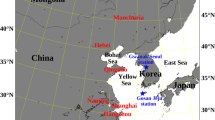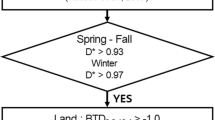Abstract
On 2 June 2014, a Haboob dust storm occurred in Tehran, which lasted less than 2 h, caused severe damages to the properties and involved loss of human life. This paper describes the behavior of this Haboob dust storm, by analyzing of metrological satellites data, as well as assessing the mesoscale and microscale patterns that led to the occurrence of the dust. A dust detection scheme was developed to monitor the dust formation using the Infrared (IR) channels of the Spinning-Enhanced Visible and Infrared Imager (SEVIRI), carried on board MSG satellites. Restrictive thresholds were placed on the individual components to maximize detection success, and to minimize the misidentification of dust. The results indicated cold and strong downdrafts along with the cold front activity during the maximum temperature over the central hot desert caused a strengthened and intensified wind velocity that led to a strong Haboob in Tehran province. The synoptic analysis indicated that a low-pressure system stretching from the southeast of Iran to the northwest of Iran and Iraq was the dominant feature, despite the presence of a weak high-pressure in the center of Iran. The satellite analysis indicates an extreme dustiness discernible in the southwest of Tehran following the formation of a convective storm; however, uncertainty in dust identification increases as the IR dust signal weakens because of underlying dust cloud beneath the thick convective clouds. The analysis of could physical properties reveals the formation of a convective storm after dramatically decrease in cloud top temperature (CTT) and cloud top pressure (CTP), and increasing the cloud optical depth (COT) which led to development of an overshooting cold cloud over Tehran province before dust formation.










Similar content being viewed by others
References
Abdi Vishkaee F, Flamant C, Cuesta J, Flamant P, Khalesifard HR (2011) Multiplatform observations of dust vertical distribution during transport over northwest Iran in the summertime. J Geophys Res Atmos. https://doi.org/10.1029/2010JD014573
Ashpole I, Washington R (2012) An automated dust detection using SEVIRI: amultiyear climatology of summertime dustiness in central and western Sahara. J Geophys Res. https://doi.org/10.1029/2011JD016845
Ashrafi K, Motlagh MS, Aslemand A (2014) Dust storm simulation over Iran using HYSPLIT. J Environ Health Sci Eng 12(1):9
Bugliaro L, Zinner T, Keil C, Mayer B, Hollmann R, Reuter M, Thomas W (2011) Validation of cloud property retrievals with simulated satellite radiances: a case study for SEVIRI. Atmos Chem Phys 11:5603–5624
Chaboureau JP, Tulet P, Mari C (2007) Diurnal cycle of dust and cirrus over West Africa as seen from Meteosat Second Generation satellite and a regional forecast model. Geophys Res Lett 34:L02822. https://doi.org/10.1029/2006GL027771
Detwiler AG, Smith P, Stith JL (1992) Observations of microphysical evolution in a High Plains thunder–storm. In: Proceedings of 11th international. conf. on clouds and precipitation, vol 1. International Commission on Clouds and Precipitation and International Association of Meteorology and Atmospheric Physics, Montreal, PQ, Canada, pp 260–263
Flamant C, Knippertz P, Chaboureau JP, Parker D, Taylor C, Cammas JP, Bock O, Timouk F, Pelon J (2007) Airborne observations of the impact of a convective system on the planetary boundary layer thermodynamics and aerosol distribution in the inter-tropical discontinuity region of the West African Monsoon. Q J R Meteorol Soc 133:1175–1189
Grell GA, Peckham SE, Schmitz R, McKeen SA, Frost G, Skamarock WC, Eder B (2005) Fully coupled online chemistry within the WRF model. Atmos Environ J 39:6957–6975
Hamidi M, Kavianpour MR, Shao Y (2013) Synoptic analysis of dust storms in the Middle East. Asia Pacific J Atmos Sci 49(3):279–286
Heinold B, Knippertz P, Marsham J, Fiedler S (2013) The role of deep convection and nocturnal low-level jets for dust emission in summertime West Africa: estimates from convection-permitting simulations. J Geophys Res Atmos 118:4385–4400. https://doi.org/10.1002/jgrd.50402
Kalnay E et al (1996) The NCEP/NCAR 40-Year reanalysis project. Bull Am Meteor Soc 77:437–471
Karami S, Ranjbar A, Mohebalhojeh AR, Moradi M (2017) A rare case of Haboob in Tehran: observational and numerical study. Atmos Res 185:169–185
Kerkmann J, Rosenfeld D, Prieto J, Lindsey D, Kollath K, Putsay M, Watts P, Koenig M (2010) Understanding convective clouds through the eyes of (MSG). Part 7: cloud particle size. jochen.kerkmann@eumetsat.int; www.eumetsat.int
King MD, Kaufman YJ, Tanré D, Nakajima T (1999) Remote sensing of tropospheric aerosols from space: past, present, and future. Bull Am Meteorol Soc 80(11):2229–2259. https://doi.org/10.1175/1520-0477(1999)080%3c2229:RSOTAF%3e2.0.CO;2
Klose M, Shao Y, Karremann K, Fink AH (2010) Sahel dust zone and synoptic background. Geophys Res Lett 37:L09802. https://doi.org/10.1029/2010GL042816
Knippertz P, Todd MC (2010) The central west Saharan dust hot spot and its relation to African easterly waves and extratropical disturbances. J Geophys Res. https://doi.org/10.1029/2009JD012819
Marsham JH, Knippertz P, Dixon NS, Parker DJ, Lister GMS (2011) The importance of the representation of deep convection for modeled dust-generating winds over West Africa during summer. J Geophys Res Lett 38:L16803. https://doi.org/10.1029/2011GL048368
Müller J (2007) MSG Level 1.5 image data format description, EUM/MSG/ICD/105. EUMETSAT, Darmstadt, Germany
Nickovic S, Kallos G, Papadopoulos A, Kakaliagou O (2001) A model for prediction of desert dust cycle in the atmosphere. J Geophys Res 106:18113–18130
Owlad E (2015) Using satellite observation for early warning of convective storm in Tehran. The international archives of the photogrammetry, remote sensing and spatial information sciences, vol XL-1/W5. 2015 international conference on sensors and models in remote sensing and photogrammetry, 23–25 Nov 2015, Kish Island, Iran
Powell J, Pedgley DE (1969) A year’s weather at Termit, Republic of Niger. Weather 24(7):247–254. https://doi.org/10.1002/j.1477-8696.1969.tb03194.x
Ridley DA, Heald CL, Pierce J, Evans M (2013) Toward resolution-independent dust emissions in global models: impacts on the seasonal and spatial distribution of dust. J Geophys Res Lett 40:2873–2877. https://doi.org/10.1002/grl.50409
Roebeling RA (2008) Cloud physical properties retrieval for climate studies using SEVIRI and AVHRR data. PhD Thesis, Wageningen University, The Netherlands, 160 pp. http://www.knmi.nl/publications.
Schepanski K, Tegen I, Laurent B, Heinold B, Macke A (2007) A new Saharan dust source activation frequency map derived from MSG-SEVIRI IR-channels. Geophys Res Lett 34:L18803. https://doi.org/10.1029/2007GL030168
Schepanski K, Tegen I, Todd MC, Heinold B, Bönisch G, Laurent B, Macke A (2009) Meteorological processes forcing Saharan dust emission from MSG-SEVIRI observations of subdaily dust source activation and numerical models. J Geophys Res 114:D10201. https://doi.org/10.1029/2008JD010325
Schmetz J, Pili P, Tjemkes S, Just D, Kerkmann J, Rota S, Ratier A (2002) An introduction to meteosat second generation (MSG). Bull Am Meteorol Soc 83:977–992
Sehatkashani S, Kmali G, Vazifedoust M, Bidokhti A (2014) Synoptic and spectral analysis of some dust events in western and southwestern Iran. Adv Environ Biol 8(13):793–806
Setvak M (2016) Satellite observations of storm tops. Use of satellite data in nowcasting high impact weather. Thessaloniki, Greece, EUMETSAT training workshop
Schroedter-Homscheidt M, Drews A, Heise S (2008) Total water vapour column retrieval from MSG-SEVIRI split window measurements exploiting the daily cycle of land surface temperatures. Remote Sens Environ 112:249–258. https://doi.org/10.1016/j.rse.2007.05.006
Shao Y, Dong CH (2006) A review on East Asian dust storm climate, modelling and monitoring. Global Planet Change 52:1–22. https://doi.org/10.1016/j.gloplacha.2006.02.011
Sodemann H, Lai TM, Marenco F, Ryder CL, Flamant C, Knippertz P, Rosenberg P, Bart M, McQuaid JB (2015) Lagrangian dust model simulations for a case of moist convective dust emission and transport in the western Sahara region during Fennec/LADUNEX. J Geophys Res Atmos 120:6117–6144. https://doi.org/10.1002/2015JD023283
Taghavi F (2010) Dust storm monitoring using satellite observatory and numerical modeling analysis. EUMETSAT2010 conference, Spain
Taghavi F, Owlad E, Ackerman SA (2017) Enhancement and identification of dust events in the south-west region of Iran using satellite observations. J Earth Syst Sci 126(2):17. https://doi.org/10.1007/s12040-017-0808-0
Vukovic A, Vujadinovic M, Pejanovic G, Andric J, Kumjian MR, Djurdjevic V, Dacic M, Prasad AK, El-Askary HM, Paris BC, Petkovic S, Nickovic S, Sprigg WA (2016) Numerical simulation of “an American haboob.” J Atmos Chem Phys 14:3211–3230. https://doi.org/10.5194/acp-14-3211-2014
Wang Y, Stein A, Draxler R, Rosa D, Zhang X (2011) Global sand and dust storms in 2008: observation and HYSPLIT model verification. Atmos Environ 45(35):6368–6381
Zhang P, Lu N, Hu X, Dong C (2006) Identification and physical retrieval of dust storm using three MODIS thermal IR channels. Global Planet Change 52:197–206
Zhao TP, Ackerman S, Guo W (2010) Dust and smoke detection for multi-channel imagers. Remote Sens 2:2347–2368
Acknowledgements
The authors would like to thank IRIMO (Iranian Meteorological Organization), Iran Department of Environment (DOE), for providing observation data for this research.
Author information
Authors and Affiliations
Corresponding authors
Additional information
Responsible Editor: Stephanie Fiedler.
Publisher's Note
Springer Nature remains neutral with regard to jurisdictional claims in published maps and institutional affiliations.
Rights and permissions
About this article
Cite this article
Tabarestani, S., Kamali, G., Vazifedoust, M. et al. Spectral and synoptic analysis of Haboob in Tehran, Iran. Meteorol Atmos Phys 133, 1029–1040 (2021). https://doi.org/10.1007/s00703-021-00790-5
Received:
Accepted:
Published:
Issue Date:
DOI: https://doi.org/10.1007/s00703-021-00790-5




